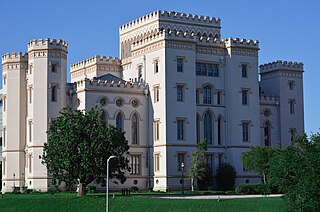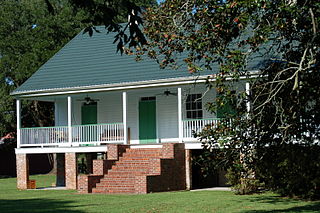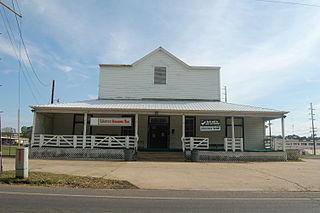
Baton Rouge is the capital city of the U.S. state of Louisiana. Located on the eastern bank of the Mississippi River, it had a population of 227,470 as of 2020; it is the seat of Louisiana's most populous parish (county-equivalent), East Baton Rouge Parish, and the center of Louisiana's second-largest metropolitan area and city, Greater Baton Rouge.

West Baton Rouge Parish is one of the sixty-four parishes in the U.S. state of Louisiana. Established in 1807, its parish seat is Port Allen. With a 2020 census population of 27,199 residents, West Baton Rouge Parish is part of the Baton Rouge metropolitan statistical area.

East Feliciana Parish is a parish located in the U.S. state of Louisiana. At the 2020 census, the population was 19,539. The parish seat is Clinton.

Port Allen is a city in, and the parish seat of, West Baton Rouge Parish, Louisiana, United States. Located on the west bank of the Mississippi River, it is bordered by Interstate 10 and US Highway 190. The population was 4,939 in 2020. It is part of the Baton Rouge metropolitan statistical area.

Louisiana State University is an American public land-grant research university in Baton Rouge, Louisiana. The university was founded in 1860 near Pineville, Louisiana, under the name Louisiana State Seminary of Learning & Military Academy. The current LSU main campus was dedicated in 1926, consists of more than 250 buildings constructed in the style of Italian Renaissance architect Andrea Palladio, and the main campus historic district occupies a 650-acre (260 ha) plateau on the banks of the Mississippi River.

Henry Watkins Allen was a Confederate military officer who was a member in the Texian Army as a soldier, while also serving as a politician, writer, enslaver, and sugar cane planter.

The Magnolia Mound Plantation House is a French Creole house constructed in 1791 near the Mississippi River in Baton Rouge, Louisiana. Many period documents refer to the plantation as Mount Magnolia. The house and several original outbuildings on the grounds of Magnolia Mound Plantation are examples of the vernacular architectural influences of early settlers from France and the West Indies. The complex is owned by the city of Baton Rouge and maintained by its Recreation Commission (BREC). It is located approximately one mile south of downtown.

Magnolia Cemetery is a 10-acre (4.0 ha) cemetery in Baton Rouge, Louisiana.

Evergreen Plantation is a plantation located on the west side of the Mississippi River in St. John the Baptist Parish, near Wallace, Louisiana, and along Louisiana Highway 18. The main house was constructed mostly in 1790, and renovated to its current Greek Revival style in 1832. The plantation's historical commodity crop was sugarcane, cultivated by enslaved African Americans until emancipation.

Longwood is a plantation located at 15417 River Road in East Baton Rouge Parish, Louisiana, which was listed on National Register of Historic Places in 1983. Directly across the street is a levee holding back the Mississippi River.

Rienzi Plantation House is a historic mansion located at 215 East Bayou Road in Thibodaux, Louisiana.

Bayside is plantation comprising a historic plantation house built in 1850 by Francis DuBose Richardson on the Bayou Teche near Jeanerette, Louisiana, United States. Richardson, a classmate and friend of Edgar Allan Poe, purchased the land for a sugar plantation.
John Hill of Homestead Plantation was a wealthy industrialist, sugar planter, philanthropist, and benefactor of Louisiana State University.

Bocage Plantation is a historic plantation in Darrow, Ascension Parish, Louisiana, about 25 miles (40 km) southeast of Baton Rouge. The plantation house was constructed in 1837 in Greek Revival style with Creole influences, especially in the floorplan. Established in 1801, the plantation was added to the National Register of Historic Places on June 20, 1991.
A. J. Meek is an American photographer, teacher, and writer. Meek is known for his selenium toned silver gelatin contact prints made with an 8 x 20 banquet camera of landscapes in Louisiana and the American West and for images that are a balance between the documentary tradition and the fine arts.

The Audubon Plantation is a Southern plantation with a historic mansion located at 21371 Hoo Shoo Too Road, Baton Rouge, Louisiana.

Allendale Plantation, also known as the Allendale Plantation Historic District, is a historic site and complex of buildings that was once a former sugar plantation founded c. 1855 and worked by enslaved African Americans. It is located in Port Allen, West Baton Rouge Parish, Louisiana.

Caspiana Plantation Store is an American historic building and a former plantation store built in 1906, located at 1300 Texas Street in Natchitoches, Louisiana. The store served as part of the crop-lien system, during the time of sharecropping which impacted the lives of many African American workers.

The Cinclare Sugar Mill Historic District is a historic industrial and residential complex on the former Marengo Plantation in unincorporated West Baton Rouge Parish, Louisiana. The district is located on the west bank of the Mississippi River between Brusly and Port Allen and across from Baton Rouge. It was listed on the National Register of Historic Places in 1998.


















